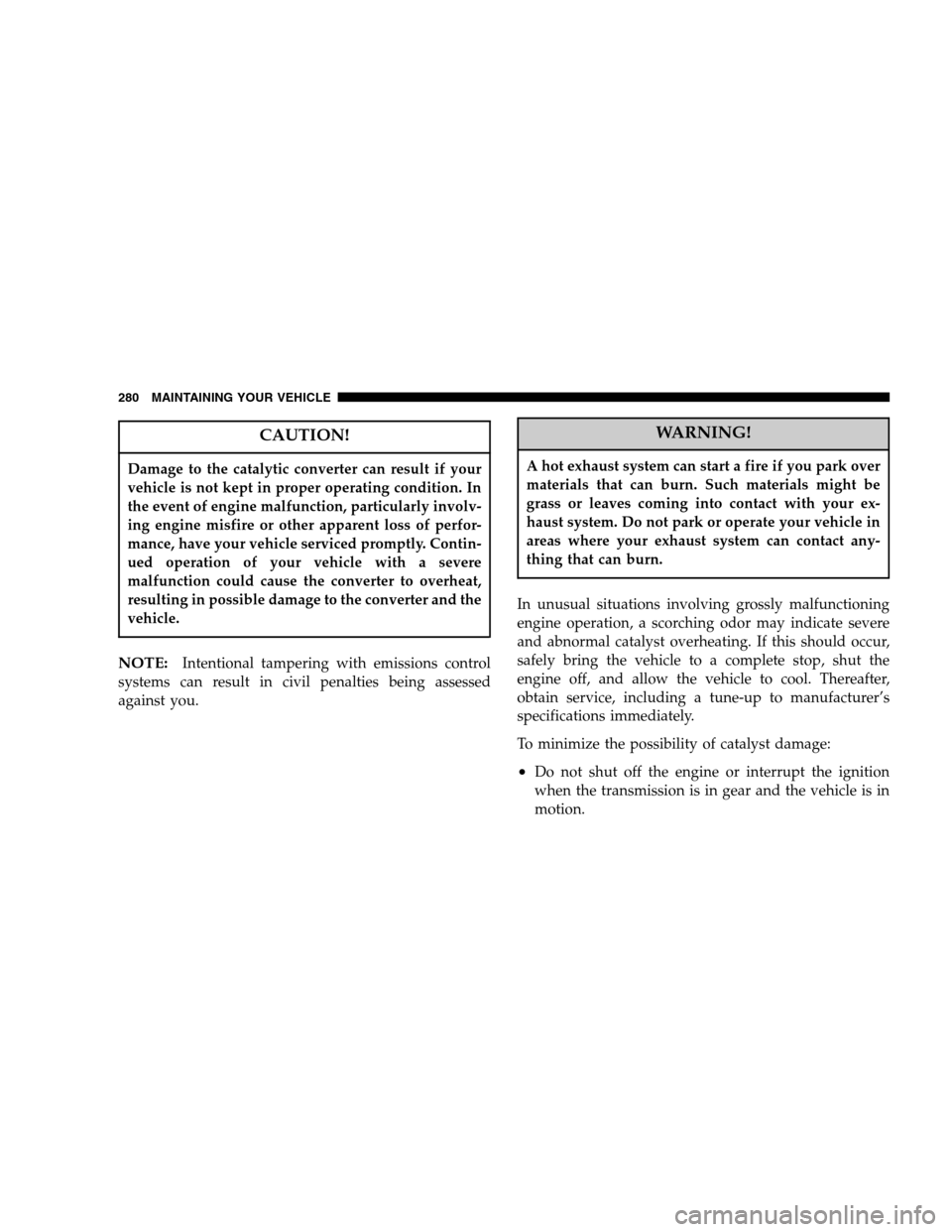2007 CHRYSLER 300 SRT engine overheat
[x] Cancel search: engine overheatPage 262 of 360

•Do not operate the electric air pump for more than
eight minutes to avoid overheating. The air pump may
be used again once it has cooled down.
•Replace the TIREFIT sealant bottle (5) once every four
years to assure optimum operation of the system.
•If TIREFIT is liquid, clean water and a damp cloth will
remove the material from the vehicle or tire and wheel
components. Once TIREFIT sealing material has dried,
it can easily be peeled off and properly discarded.
•Do not exceed 55 mph (90 km/h) until the tire has
been inspected.
JUMP-STARTING PROCEDURES
WARNING!
•Take care to avoid the radiator cooling fan whenever the
hood is raised. It can start anytime the ignition switch is on.
You can be hurt by the fan.
•Do not attempt to push or tow your vehicle to get it started.
Vehicles equipped with an automatic transmission cannot
be started this way. Unburned fuel could enter the catalytic
converter and once the engine has started, ignite and
damage the converter and vehicle. If the vehicle has a
discharged battery, booster cables may be used to obtain a
start from another vehicle. This type of start can be danger-
ous if done improperly, so follow this procedure carefully.
•Battery fluid is a corrosive acid solution; do not allow
battery fluid to contact eyes, skin, or clothing. Don’t lean
over battery when attaching clamps or allow the clamps to
touch each other. If acid splashes in eyes or on skin, flush
contaminated area immediately with large quantities of
water.
•A battery generates hydrogen gas, which is flammable and
explosive. Keep flame or spark away from the vent holes.
•Do not use a booster battery or any other booster source
with an output that exceeds 12 volts.
•The battery in this vehicle has a vent hose that should not
be disconnected and should only be replaced with a battery
of the same type (vented).
262 WHAT TO DO IN EMERGENCIES
Page 265 of 360

FREEING A STUCK VEHICLE
If your vehicle becomes stuck in mud, sand, or snow, it
can often be moved by a rocking motion. Turn your
steering wheel right and left to clear the area around the
front wheels. Then shift back and forth between Reverse
and Drive. Usually the least accelerator pedal pressure to
maintain the rocking motion without spinning the
wheels is most effective.
NOTE:Turn off the Electronic Stability Program (ESP)
before rocking the vehicle. For details, refer to “Electronic
Stability Program,” or “Traction Control” in this manual.
CAUTION!
•When “rocking” a stuck vehicle by moving be-
tween “First” and R (Reverse), do not spin the
wheels faster than 15 mph (24 km/h), or drivetrain
damage may result.
•Racing the engine or spinning the wheels too fast
may lead to transmission overheating and failure.
It can also damage the tires. Do not spin the
wheels above 35 mph (55 km/h).
WARNING!
Fast spinning tires can be dangerous. Forces gener-
ated by excessive wheel speeds may cause tire dam-
age or failure. A tire could explode and injure
someone. Do not spin your vehicle’s wheels faster
than 35 mph (55 km/h) when you are stuck, and don’t
let anyone near a spinning wheel, no matter what the
speed.
WHAT TO DO IN EMERGENCIES 265
6
Page 280 of 360

CAUTION!
Damage to the catalytic converter can result if your
vehicle is not kept in proper operating condition. In
the event of engine malfunction, particularly involv-
ing engine misfire or other apparent loss of perfor-
mance, have your vehicle serviced promptly. Contin-
ued operation of your vehicle with a severe
malfunction could cause the converter to overheat,
resulting in possible damage to the converter and the
vehicle.
NOTE:Intentional tampering with emissions control
systems can result in civil penalties being assessed
against you.
WARNING!
A hot exhaust system can start a fire if you park over
materials that can burn. Such materials might be
grass or leaves coming into contact with your ex-
haust system. Do not park or operate your vehicle in
areas where your exhaust system can contact any-
thing that can burn.
In unusual situations involving grossly malfunctioning
engine operation, a scorching odor may indicate severe
and abnormal catalyst overheating. If this should occur,
safely bring the vehicle to a complete stop, shut the
engine off, and allow the vehicle to cool. Thereafter,
obtain service, including a tune-up to manufacturer’s
specifications immediately.
To minimize the possibility of catalyst damage:
•Do not shut off the engine or interrupt the ignition
when the transmission is in gear and the vehicle is in
motion.
280 MAINTAINING YOUR VEHICLE
Page 290 of 360

WARNING!
•The warning words “DO NOT OPEN HOT” on
the cooling system pressure cap are a safety pre-
caution. Never add coolant when the engine is
overheated. Do not loosen or remove the cap to
cool an overheated engine. Heat causes pressure
to build up in the cooling system. To prevent
scalding or injury, do not remove the pressure cap
while the system is hot or under pressure.
•Do not use a pressure cap other than the one
specified for your vehicle. Personal injury or
engine damage may result.
Disposal of Used Coolant
Used ethylene glycol based engine coolant is a regulated
substance requiring proper disposal. Check with your
local authorities to determine the disposal rules for your
community. To prevent ingestion by animals or children,
do not store ethylene glycol based engine coolant in open
containers or allow it to remain in puddles on theground. If ingested by a child, contact a physician
immediately. Clean up any ground spills immediately.
Coolant Level
The coolant bottle provides a quick visual method for
determining that the coolant level is adequate. With the
engine off and cold, the level of the coolant in the bottle
should be between the ranges indicated on the bottle.
The radiator normally remains completely full, so there is
no need to remove the radiator cap unless checking for
coolant freeze point or replacing coolant. Advise your
service attendant of this. As long as the engine operating
temperature is satisfactory, the coolant bottle need only
be checked once a month.
When additional coolant is needed to maintain the
proper level, it should be added to the coolant bottle. Do
not overfill.
Points To Remember
NOTE:
When the vehicle is stopped after a few miles
(kilometers) of operation, you may observe vapor coming
from the front of the engine compartment. This is nor-
mally a result of moisture from rain, snow, or high
290 MAINTAINING YOUR VEHICLE
Page 349 of 360

Door Locks............................ 21
Door Locks, Automatic................... 22
Door Opener, Garage.................... 116
DriveBelts ............................ 278
Driving
On Slippery Surfaces.................. 209
DVD Player (Video Entertainment System).... 174
Electric Remote Mirrors................... 64
Electrical Power Outlets.................. 124
Electronic Brake Control System............ 214
Electronic Speed Control (Cruise Control)..... 109
Electronic Stability Program (ESP).......... 216
Electronic Throttle Control Warning Light..... 141
Electronic Vehicle Information Center (EVIC) . . 144
Emergency, In Case of
Freeing Vehicle When Stuck............. 265
Hazard Warning Flasher................ 256
JumpStarting ........................ 262
Overheating......................... 256
Towing ............................. 266
Emission Control System Maintenance....273,318
Engine............................... 271Air Cleaner.......................... 279
Block Heater......................... 199
Break-In Recommendations............... 55
Checking Oil Level.................... 275
Compartment........................ 271
Coolant (Antifreeze)................287,314
Cooling ............................ 287
Exhaust Gas Caution................ 56,248
FailstoStart ......................... 197
Flooded, Starting..................... 197
Fuel Requirements.................246,313
Oil ..........................275,313,314
Oil Change Interval................... 276
Oil Filler Cap........................ 277
OilSelection ......................277,313
Overheating......................... 256
Temperature Gauge................... 139
Enhanced Accident Response Feature......... 45
Ethanol.............................. 247
Event Data Recorder..................... 46
Exhaust Gas Caution............. 56,57,248,286
Exhaust System...................... 56,286
ExteriorFoldingMirrors .................. 64
INDEX 349
10
Page 355 of 360

Overhead Console...................... 115
Overheating, Engine..................... 256
Owner’s Manual (Operator Manual)......... 341
Panic Alarm........................... 19
Park Assist System, Rear................. 112
Parking Brake......................... 210
Parking On Hill........................ 210
Passing Light........................... 99
Pedals, Adjustable...................... 108
Personal Settings....................... 153
Pets .................................. 55
Phone, Cellular......................... 66
Phone, Hands-Free (UConnect™)............ 66
Placard, Tire and Loading Information....... 225
Power
Brakes............................. 211
Distribution Center (Fuses).............. 300
Door Locks.......................... 21
Mirrors ............................. 64
Outlet(AuxiliaryElectricalOutlet) ........ 124
Seats............................... 85
Steering.........................213,284Steering, Checking.................... 284
Sunroof............................ 121
Tilt/Telescoping Steering Column......... 107
Windows............................ 25
Pregnant Women and Seat Belts............. 37
Pretensioners
Seat Belts............................ 35
Programmable Electronic Features..... 117,120,153
Programming Transmitters
(Remote Keyless Entry)............. 19,117,120
Radial Ply Tires........................ 232
Radiator Cap (Coolant Pressure Cap)........ 289
Radio Broadcast Signals.................. 158
Radio, Navigation...................... 170
Radio Operation.....................159,183
Radio Remote Controls.................. 179
Radio, Satellite......................171,176
Radio (Sound Systems)................... 159
Rain Sensitive Wiper System.............. 102
Rear Park Assist System.................. 112
Rear Seat, Folding....................... 89
Rear Window Defroster.................. 191
INDEX 355
10